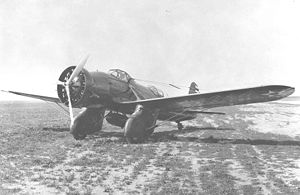The Curtiss YA-10 Shrike (Model 59B) was a 1930s United States test and development version of the A-8 Shrike ground-attack aircraft using various radial engines in place of the inline engine.
| YA-10 Shrike | |
|---|---|
 | |
| General information | |
| Type | Ground attack |
| Manufacturer | Curtiss/Curtiss-Wright |
| Primary users | United States Army Air Corps |
| Number built | 2 |
| History | |
| Introduction date | 1933 |
| First flight | 1932 |
| Retired | 1939 |
| Developed from | A-8 Shrike |
| Developed into | A-12 Shrike |
Development
editThe Curtiss YA-10 Shrike was the first YA-8 fitted with a Pratt & Whitney R-1690-9 (R-1690D) Hornet radial engine. The conversion was carried out in September 1932, and it was found that the aircraft's performance was not degraded by the change of engine, and low-level maneuverability was improved due to the lower mass moment of inertia with the short radial engine. The USAAC preferred radials to inline engines for the ground attack role, due to the vulnerability of the latter's cooling system to anti-aircraft fire. The US Navy also preferred radials for carrier-borne operations.[1] Upon completion of testing the Army changed an order for 46 A-8B aircraft to the production version of the YA-10, the A-12 Shrike.
Operational history
editFollowing completion of testing, the YA-10 was assigned to the 3rd Attack Group for operational service, then in 1934 it was assigned to the Command and General Staff School. The YA-10 was scrapped in early 1939.
The XS2C-1 was the Navy's first two-seat warplane. Since it was not equipped for carrier operations, it remained a prototype.[1]
Variants
edit- YA-10
- Model 59B, one U.S. Army Air Corps prototype
- XS2C-1
- Model 69, one U.S. Navy prototype with a 625 hp (466 kW) Wright R-1510-28 Whirlwind engine, delivered December 1932[2]
Operators
editSpecifications (YA-10)
editData from Aerofiles : Curtiss,[3] Curtiss Aircraft 1907–1947[4]
General characteristics
- Crew: 2
- Length: 32 ft 0 in (9.75 m)
- Gross weight: 6,135 lb (2,783 kg)
- Powerplant: 1 × Pratt & Whitney R-1690D Hornet 9-cylinder air-cooled radial piston engine, 625 hp (466 kW)
- Propellers: 3-bladed variable-pitch propeller
Performance
- Maximum speed: 175 mph (282 km/h, 152 kn)
- Cruise speed: 148 mph (238 km/h, 129 kn)
- Stall speed: 67 mph (108 km/h, 58 kn)
Armament
- Guns: 4 × fixed forward-firing 0.30 in (7.62 mm) machine-gun, with another in the rear cockpit on a flexible mount
- Bombs: 10 × 30 lb (14 kg) bombs or 4 × 122 lb (55 kg) bombs
See also
editRelated development
Aircraft of comparable role, configuration, and era
Related lists
References
edit- ^ a b Fitzsimmons, Bernard, ed. (1967). The Illustrated encyclopedia of 20th century weapons and warfare (Volume 21 ed.). Purnell Reference Books. ISBN 0-8393-6175-0.
- ^ Eden, Paul; Moeng, Soph, eds. (2002). The Complete Encyclopedia of World Aircraft. London, NI 9PF: Barnes & Noble Books. ISBN 0-7607-3432-1.
{{cite book}}: CS1 maint: location (link) - ^ Eckland, K.O. "Curtiss # to J". aerofiles.com. Retrieved 2019-04-14.
- ^ Bowers, Peter M. (1979). Curtiss aircraft, 1907-1947. London: Putnam. pp. 326–331. ISBN 0370100298.